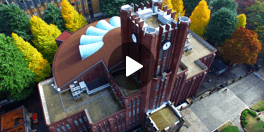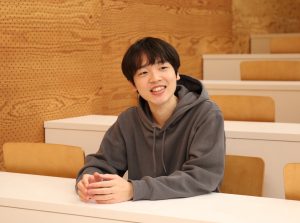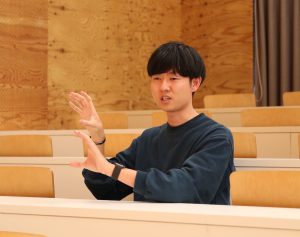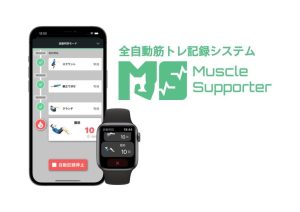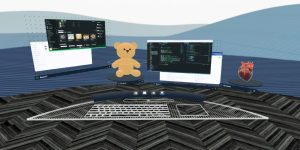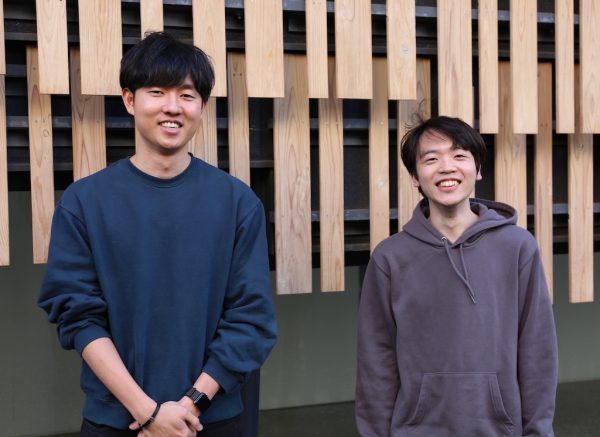
April 6, 2023
情報技術を使って社会の課題を解決したいー「未踏スーパークリエータ」江口大志さん、下島銀士さんインタビューSolving society’s problems with information technology: An interview with "MITOU Super Creators" Taishi Eguchi and Ginshi Shimojima
2023年4月に学際情報学府修士課程の2年目を迎えた江口大志さん(総合分析情報学コース・暦本研究室)と下島銀士さん(先端表現情報学コース・矢谷研究室)は、学府入学直後の2022年5月、経済産業省の未踏IT人材発掘・育成事業の「スーパークリエータ」に認定されました。これは、突出したIT人材を発掘・育成する目的で経産省が毎年開催するこの事業への参加者の中から、特に卓越した能力をもったとされる人に与えられる栄誉で、二人は2021年度の参加者から選ばれました。新年度に先立ち、未踏プロジェクトのこと、また学府での学生生活についてお話を伺いました。
江口さんと下島さんは、未踏プロジェクトでそれぞれの仲間とともに、既存のソフトウェアではできなかったことを可能にするシステムを開発しました。江口さんのチームが創ったのは、XR向けWindow System「ZIGEN」。XRとはクロスリアリティ(cross reality)と読み、仮想現実(VR)や拡張現実(AR)、複合現実(MR)の総称で、Window Systemとは、OSの上で複数のアプリを実行する仕組みのことを指します。私たちがパソコンでSlackとZoomとChromeといった開発元の異なるアプリを起動しマルチタスクできるのは、二次元(2D)空間で働くWindow Systemがそれを可能にしているからですが、既存の三次元(3D)空間においては、事実上ひとつのアプリが実行する環境しか動かすことができない状況です。江口さんたちの開発した「ZIGEN」は、既存の3D空間にWindow Systemを持ち込むことで、ひとつの3D空間で複数の開発元の異なる3D/2Dアプリを扱うことを可能にします。世界に先駆けて開発したこの画期的なWindow Systemを、江口さんたちはオープンソースにし、世界中の開発者とよりよいものに育てていきたいといいます。
一方、下島さんたちのチームは、筋トレを全自動で記録できるiOSアプリとそれを支えるシステム「Muscle Supporter」を開発。筋肉を鍛えようとするならば、たとえば腹筋を何回、スクワットを何回やったと記録することが大切ですが、記録するには既存のトレーニング用アプリでも自分で入力の必要があったりするなど、手間がかかります。今回、下島さんたちが開発した「Muscle Supporter」は、アプリを1タップするだけで、取り組んだ筋トレの種別と回数がすべて自動的に識別され、記録されるという、ユーザーに使いやすいものです。iPhoneとApple Watchのモーションセンサーの時系列データから、筋トレの種目を自動的に判別する仕組みを開発する上で、下島さんたちは体を張って筋トレをし、データを取ったそうです。アプリはApp Storeからダウンロードできます。
これまでになかった、画期的で実用性の高いシステムを開発した江口さんと下島さん。「情報技術を使って社会の課題を解決したい」と明るく語ります。未踏では、開発に専念するための環境が提供されたのみならず、メンターや他の参加者との交流も大切な経験となったといいます。当時ともに学部の4年生だった二人が進路に学際情報学府を選んだのは、学環に指導を受けたい教授がいらっしゃったこと、ヒューマン・コンピュータ・インタラクション(HCI)分野の先生方が多いこと、また学府のカリキュラムの柔軟さなどを魅力に感じたことだったそうです。
修士課程1年目を振り返り、江口さんと下島さんは、専門の枠を超えた視点に接する機会が多いのは学府ならではといいます。入学直後に受けた学際情報学概論の授業で、自らの専門とは異なる分野について学び、考えられたことは、とても興味深かったとのこと。学府のよさとして、江口さんは他コースの人とのつながりができ、コミュニケーションの幅が広がったことを挙げます。制作展にも参加した下島さんは、技術と人が関わるメディアアートに触れられたことも、とても有意義だったと話されました。
新年度はいよいよ修論です。江口さんは「ZIGEN」をさらに発展させることをテーマに、下島さんは、薬物依存症患者の認知療法プログラムを情報技術で支援する方法を模索する研究に取り組む予定です。
〈LINKS〉
江口さんの未踏成果報告動画:https://www.youtube.com/watch?v=g_MvbwKp8Uk
下島さんの未踏成果報告動画:https://www.youtube.com/watch?v=4hfS73tbDNY
記事:神谷説子(特任助教・編集部)
写真:柳志旼(博士課程・編集部)
Shortly after beginning their first year in the master’s program at the GSII, Taishi Eguchi and Ginshi Shimojima were certified in May 2022 as “MITOU Super Creators” by the Ministry of Economy, Trade and Industry. The annual MITOU program aims to discover young individuals with outstanding IT abilities and the potential to create new added value. The two were selected for the prestigious honor from among those who participated in the program in the academic year of 2021. Together with their respective colleagues, Mr. Eguchi (Applied computer science course, Rekimoto Lab) and Mr. Shimojima (Emerging design and informatics course, Yatani Lab) have each developed innovative and highly practical software systems.
Mr. Eguchi’s team created “ZIGEN,” a window system for XR*. Unlike two-dimensional space, such as on personal computers, where we can multitask by launching different apps from different developers, such as Slack, Google and Zoom, conventional three-dimensional space does not allow different apps from different developers to run simultaneously. However, by applying the ZIGEN window system, one can now use multiple 3D/2D apps from different developers in a single 3D space. This new window system is globally considered a pioneering work. Mr. Eguchi and his teammates made ZIGEN an open-source software so that they can collaborate with developers around the world to make further improvements.
Meanwhile, Mr. Shimojima and his colleagues developed an iOS app called “Muscle Supporter.” Those who enthusiastically train their muscles may know that it is important to keep track of how many sit-ups and squats you have done, and yet the recording process is bothersome. But with Muscle Supporter app, all you need is a single tap on the app, as it automatically identifies and records the types of training you have worked on. Such an easy-to-use feature is the first among similar muscle training apps that Shimojima’s team have developed based on time-series data from iPhone and Apple Watch motion sensors. The Muscle Supporter app can be downloaded from iPhone’s App Store.
While describing their projects in this interview, Mr. Eguchi and Mr. Shimojima both said they were eager to apply information technology to solve problems in society. The MITOH experience not only provided them with an environment that allowed them to concentrate on their proposed projects, but the interactions with their mentors and other participants were valuable, they said. Mr. Eguchi and Mr. Shimojima decided to pursue their master’s degree at GSII while working on their MITOH projects in their final year as undergraduate students. The two said they were attracted by the fact that many faculty members are specialized in Human Computer Interaction, the area of their own interests, as well as by the flexibility of the GSII’s curriculum.
Reflecting on their first year in the master’s program, Mr. Eguchi and Shimojima feel that GSII has provided them with unique opportunities to learn about different fields of study. Mr. Eguchi said being able to meet people in other fields even in the same graduate school has been a rewarding experience. Meanwhile, Mr. Shimojima noted that participating in the annual iii Exhibition organized by the GSII was also meaningful as it exposed him to media art, where technology and culture meet.
Now that their second year has begun, the two students will concentrate on compiling their master’s theses. Mr. Eguchi will focus on further developing “ZIGEN,” while Mr. Shimojima plans to conduct research on how to use information technology to support cognitive therapy programs for drug addicts.
* an abbreviation for “cross reality” which includes virtual reality (VR), augmented reality (AR) and mixed reality (MR).
〈LINKS〉
Eguchi team MITOH final report: https://www.youtube.com/watch?v=g_MvbwKp8Uk
Shimojima team MITOH final report: https://www.youtube.com/watch?v=4hfS73tbDNY
Text: Setsuko Kamiya (Project assistant professor, Editorial team)
Photo: Jimmine Yoo(Doctoral student, Editorial team)

